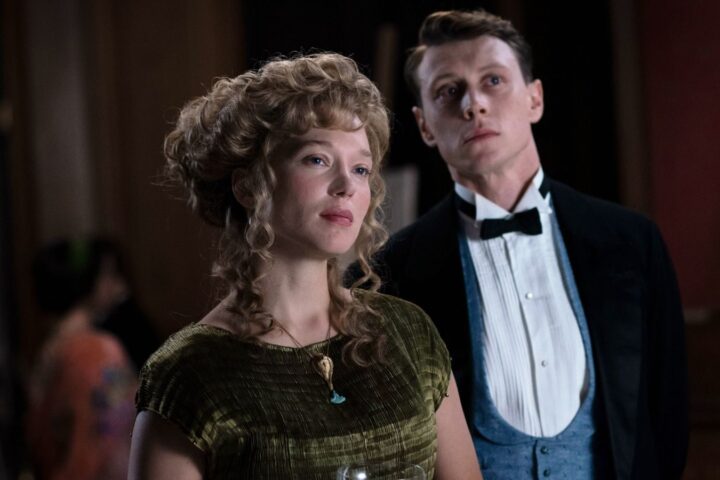Alice Diop’s Saint Omer brings the French filmmaker into the realm of fiction for the first time, but preserves her documentary respect for the evidence of the audience’s eyes. A sober, pared-down courtroom drama, Saint Omer initially makes little effort to comment on its action, at times feeling more like presentation than representation. The unadorned quality of the film can be laborious, particularly in the early stretches of the trial that’s at the center of the story, but Diop earns the effort she asks of her audience, methodically allowing a strange, intangible, but nevertheless palpable mix of emotions to emerge from the situation itself.
It’s certainly a choice, and the expression of an ethos, that Diop keeps the viewer locked in to repeating pairs of alternating camera angles for significant portions of the trial. We see the defendant, Laurence Coly (Guslagie Malanda), a Senegalese immigrant and philosophy graduate student accused of intentionally drowning her 15-month-old daughter, framed slightly obliquely against the neutral golden brown of wooden courtroom wall panel as she testifies. Then we get a medium close-up on the judge (Valérie Dréville), posing probing questions. Diop will repeat this process until a shift in the courtroom procedure justifies adjusting the angles a bit.
During these scenes we don’t even seem to be viewing the proceedings through the eyes of the character who’s set up to be our focal point, Rama (Kayije Kagame). Rama is a novelist and academic attending the trial in order to adapt Coly’s story into a modern retelling of the Greek myth of Medea. But while we spend the first 15 minutes of the film getting to know Rama’s life in Paris a bit—she has a complicated relationship to her own Senegalese-French mother—and follow her into the courtroom, Diop is mostly uninterested in framing the trial purely in terms of Rama’s processing or reaction to it, at least until later in Saint Omer.
There’s a directness to this approach, an artful unartfulness, that refocuses the viewer on Coly’s testimony and that of Luc Dumontet (Xavier Maly), the much older white man who was the father of the daughter she admits she murdered. While at the beginning of the trial, Coly strikes a disturbingly neutral tone considering the heinousness of her crime—when asked by the court why she did it, she responds that she hopes the trial will help her determine the answer—the knotty inscrutability of her actions gradually becomes a profound token of her humanity.
In a sense, then, we do share Rama’s perspective on the trial, as she, too, finds it hard to impose her Medea framework on Coly’s story. Kagame plays Rama as quiet and restrained—at least outside of the classroom, where we see her lecturing on Marguerite Duras and Hiroshima Mon Amour in the film’s opening. In periodic flashbacks and video tapes, revisited in an early scene when she and her white partner, Adrien (Thomas De Pourquery), visit her mother’s house, we catch glimpses of her as a sullen child, perhaps damaged by her own mother’s emotional neglect.
The case clearly begins resonating for Rama not with the story of Medea, a reference point as reflexively intellectual and Western as Marguerite Duras, but with her own backstory. We gather this when we follow Rama back to her hotel room during breaks in the trial, as she discusses the book with Adrien and her publisher over the phone. Pregnant herself—as Coly’s mother, Odile (Salimata Kamate), divines in conversation—Rama has ample reason to reconsider making literary hay of the strife, pain, and tragedy of black mothers and daughters.
Subsequent witnesses in the trial also make it increasingly clear that, while Coly’s action may be inexcusable and her account of events strangely incoherent, she was also painted into a corner well before taking the stand in Diop’s claustrophobic frame. It’s evident that Dumontet thought nothing of using her and disregarding their child, and her former professor forwards the racist suggestion that an African isn’t capable of writing a thesis on Wittgenstein.
Rama shoots a look of deep, burning anger toward the witness stand when Coly’s advisor intones this absurdly prejudiced opinion, and ends up locking eyes with the woman in the defendant’s box. In this riveting latter part of Saint Omer, Diop treats the space of the courtroom with a bit more flexibility, moving from the pointedly cold presentation of the first half to slightly more expressive cutting as the drama moves from beyond the benches and involves Rama in a series of such implicit, fraught psychological transferences.
Saint Omer crescendos in a surprisingly emotional finale, considering the aesthetics of austerity that brought us there. Diop balances the generic (not to mention legal) expectation that the trial will offer answers with her conviction that neither what happened nor what’s going on in the courtroom can really be put into words. If courtroom dramas are usually about taking a stand, here Diop shows us that the most impactful truths often go unspoken.
Image/Sound
The disc’s image, sourced from a 2K digital master, is incredibly detailed, which is absolutely crucial for a film that predominantly takes places in one setting. There’s a burnished quality to Saint Omer’s lighting that’s brought out by the excellent depth of field of the color palette. Skin tones are incredibly warm and accurate, while delineation is strong throughout.
While the included 5.1 surround DTS-HD Master Audio soundtrack isn’t going to give your home system’s audio setup a workout, given that this is a largely dialogue-driven film with no score, moments where it’s difficult to trace the origins of breathing sounds are enveloping and haunting. Dialogue, firmly planted in the center, is consistently clean and clear throughout, while the sound design is subtly alive to the courtroom’s acoustics.
Extras
Alice Diop discusses the themes of her first fiction feature, including her fascination with the gaze, in a series of new and archival interviews, as well as two conversations, one with scholar and philosopher Hélène Frappat and one with filmmaker Dee Rees. Frappat and Rees’s appreciation for Saint Omer is undeniable, but Rees’s is especially inspiring, especially when she homes in on Diop’s upending of true crime conventions when she compares the film to the work of Truman Capote. The extras are rounded out by a thoughtful essay by critic Jennifer Padjemi that discusses Saint Omer’s various themes and places the film in the context of Diop’s career, which up to this point consisted entirely of documentaries.
Overall
Alice Diop’s riveting meta-drama receives a handsome A/V presentation, and a series of extras that exalt its complex, wide-ranging themes.
Since 2001, we've brought you uncompromising, candid takes on the world of film, music, television, video games, theater, and more. Independently owned and operated publications like Slant have been hit hard in recent years, but we’re committed to keeping our content free and accessible—meaning no paywalls or fees.
If you like what we do, please consider subscribing to our Patreon or making a donation.




